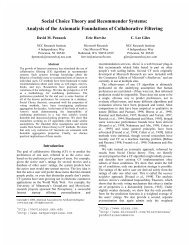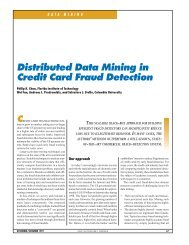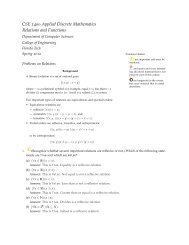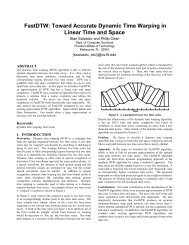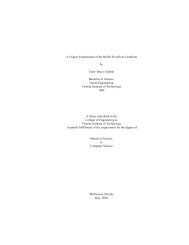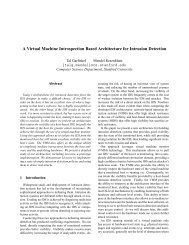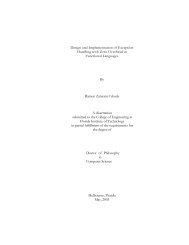Network Traffic Anomaly Detection Based on Packet Bytes
Network Traffic Anomaly Detection Based on Packet Bytes
Network Traffic Anomaly Detection Based on Packet Bytes
You also want an ePaper? Increase the reach of your titles
YUMPU automatically turns print PDFs into web optimized ePapers that Google loves.
<str<strong>on</strong>g>Network</str<strong>on</strong>g> <str<strong>on</strong>g>Traffic</str<strong>on</strong>g> <str<strong>on</strong>g>Anomaly</str<strong>on</strong>g> <str<strong>on</strong>g>Detecti<strong>on</strong></str<strong>on</strong>g> <str<strong>on</strong>g>Based</str<strong>on</strong>g> <strong>on</strong> <strong>Packet</strong> <strong>Bytes</strong>Matthew V. Mah<strong>on</strong>eyFlorida Institute of Technology Technical Report CS-2002-13mmah<strong>on</strong>ey@cs.fit.eduABSTRACTHostile network traffic is often "different" from benign trafficin ways that can be distinguished without knowing the nature ofthe attack. We describe a two stage anomaly detecti<strong>on</strong> system foridentifying suspicious traffic. First, we filter traffic to pass <strong>on</strong>lythe packets of most interest, e.g. the first few packets of incomingserver requests. Sec<strong>on</strong>d, we model the most comm<strong>on</strong> protocols(IP, TCP, telnet, FTP, SMTP, HTTP) at the packet byte level toflag events (byte values) that have not been observed for a l<strong>on</strong>gtime. This simple system detects 132 of 185 attacks in the 1999DARPA IDS evaluati<strong>on</strong> data set [5] with 100 false alarms, aftertraining <strong>on</strong> <strong>on</strong>e week of attack-free traffic.1. INTRODUCTION<str<strong>on</strong>g>Network</str<strong>on</strong>g> intrusi<strong>on</strong> detecti<strong>on</strong> systems are classified assignature based or anomaly based. A signature detector, such asSNORT [13] or Bro [10] examines traffic for known attacks usingrules written by security experts. When a new type of attack isdiscovered, new rules must be written and distributed. Ananomaly detecti<strong>on</strong> system such as SPADE [15], ADAM [14], orNIDES [1] models normal traffic, usually the distributi<strong>on</strong> of IPaddresses and ports. Hostile traffic often falls outside thisdistributi<strong>on</strong>. <str<strong>on</strong>g>Anomaly</str<strong>on</strong>g> detecti<strong>on</strong> has the advantage that no rulesneed to be written, and that it can detect novel attacks. But it hasthe disadvantages that it cannot say anything about the nature ofthe attack (since it is novel), and because normal traffic may alsodeviate from the model, generating false alarms. An anomalydetector can <strong>on</strong>ly bring the suspicious traffic to the attenti<strong>on</strong> of anetwork security expert, who must then figure out what, ifanything, needs to be d<strong>on</strong>e.Mah<strong>on</strong>ey and Chan [6, 7, 8] identify five types of anomaliesin hostile traffic.• User Behavior. Hostile traffic may have a novel sourceaddress because it comes from an unauthorized user of arestricted (password protected) service. Also, probes such asipsweep and portsweep [4] may attempt to access n<strong>on</strong>existenthosts and services, generating anomalies in the destinati<strong>on</strong>addresses and port numbers.• Bug Exploits. Attacks often exploit errors in the targetsoftware, for example, a buffer overflow vulnerability. Sucherrors are most likely to be found in the least-used features ofthe program, because otherwise the error is likely to havebeen discovered during normal use and fixed in a laterversi<strong>on</strong>. Thus, any remaining errors are invoked <strong>on</strong>ly withunusual inputs (e.g. a very l<strong>on</strong>g argument to a seldom usedcommand), which are not likely to occur during normal use.• Resp<strong>on</strong>se Anomalies. Sometimes a target will generateanomalous outgoing traffic in resp<strong>on</strong>se to a successful attack,for example, a victimized mail server passing root shellcommand resp<strong>on</strong>ses back to an attacker. This is analogous toForrest's host based detecti<strong>on</strong> method [2], where a servercompromise can be detected because it makes unusualsequences of system calls.• Bugs in the attack. Attackers typically must implementclient protocols themselves, and will fail to duplicate thetarget envir<strong>on</strong>ment either out of carelessness or because it isnot necessary. For example, many text based protocols suchas FTP, SMTP and HTTP allow either uppercase orlowercase commands. An attacker may use lowercase forc<strong>on</strong>venience, even though normal clients might always useuppercase.• Evasi<strong>on</strong>. Attackers may deliberately manipulate networkprotocols to hide an attack from an improperly codedintrusi<strong>on</strong> detecti<strong>on</strong> system (IDS) m<strong>on</strong>itoring the applicati<strong>on</strong>layer [3, 12]. Such methods include IP fragmentati<strong>on</strong>,overlapping TCP segments that do not match, deliberate useof bad checksums, short TTL values, and so <strong>on</strong>. Such eventsmust be rare in normal traffic, or else the IDS would havebeen written to handle them properly.Given the variety of anomalies, it makes sense to examine asmany attributes as possible, not just the packet ports andaddresses, as many systems now do. Also, because networktraffic has n<strong>on</strong>stati<strong>on</strong>ary or self-similar behavior [11], it makessense to use a n<strong>on</strong>stati<strong>on</strong>ary model, in which the probability of anevent depends <strong>on</strong> the time since it last occurred, instead of <strong>on</strong> itsaverage rate. The idea is that if an attribute takes <strong>on</strong> a novelvalue, or at least <strong>on</strong>e not seen recently, then the data is suspicious.The rest of this paper is organized as follows. In Secti<strong>on</strong> 2,we describe related work in network anomaly detecti<strong>on</strong>. InSecti<strong>on</strong> 3, we describe our <str<strong>on</strong>g>Network</str<strong>on</strong>g> <str<strong>on</strong>g>Traffic</str<strong>on</strong>g> <str<strong>on</strong>g>Anomaly</str<strong>on</strong>g> Detector(NETAD), which flags suspicious packets based <strong>on</strong> unusual bytevalues in network packets. In Secti<strong>on</strong> 4, we evaluate NETAD <strong>on</strong>the 1999 DARPA evaluati<strong>on</strong> data set [5]. In Secti<strong>on</strong> 5, wesummarize.2. RELATED WORK<str<strong>on</strong>g>Network</str<strong>on</strong>g> intrusi<strong>on</strong> detecti<strong>on</strong> systems such as SNORT [13] andBro [10] use hand written rules to detect signatures of knownattacks, such as a specific string in the applicati<strong>on</strong> payload, orsuspicious behavior, such as server requests to unused ports.<str<strong>on</strong>g>Anomaly</str<strong>on</strong>g> detecti<strong>on</strong> systems such as SPADE [15], ADAM [14],and NIDES [1] learn a statistical model of normal network traffic,and flag deviati<strong>on</strong>s from this model. Models are usually based <strong>on</strong>the distributi<strong>on</strong> of source and destinati<strong>on</strong> addresses and ports pertransacti<strong>on</strong> (TCP c<strong>on</strong>necti<strong>on</strong>s, and sometimes UDP and ICMPpackets). For example, SPADE offers four models of incomingTCP c<strong>on</strong>necti<strong>on</strong>s:• P(destinati<strong>on</strong>-address, destinati<strong>on</strong>-port)• P(source-address, destinati<strong>on</strong>-address, destinati<strong>on</strong>-port)• P(source-address, source-port, destinati<strong>on</strong>-address,destinati<strong>on</strong>-port)• Bayes network approximati<strong>on</strong> of the above.
Lower probabilities result in higher anomaly scores, since theseare presumably more likely to be hostile.ADAM is a classifier which can be trained <strong>on</strong> both knownattacks and <strong>on</strong> (presumably) attack-free traffic. Patterns which d<strong>on</strong>ot match any learned category are flagged as anomalous. ADAMalso models address subnets (prefixes) in additi<strong>on</strong> to ports andindividual addresses. NIDES is a comp<strong>on</strong>ent of EMERALD [9],a system that integrates host and network based techniques usingboth signature and anomaly detecti<strong>on</strong>. The NIDES comp<strong>on</strong>ent,like SPADE and ADAM, models ports and addresses, flaggingdifferences between short and l<strong>on</strong>g term behavior.SPADE, ADAM, and NIDES use stati<strong>on</strong>ary models, in whichthe probability of an event is estimated by its average frequencyduring training. PHAD [6], ALAD [8], and LERAD [7] usen<strong>on</strong>stati<strong>on</strong>ary models, in which the probability of an eventdepends instead <strong>on</strong> the time since it last occurred. For eachattribute, they collect a set of allowed values (anything observedat least <strong>on</strong>ce in training), and flag novel values as anomalous.Specifically, they assign a score of tn/r to a novel valued attribute,where t is the time since the attribute was last anomalous (duringeither training or testing), n is the number of trainingobservati<strong>on</strong>s, and r is the size of the set of allowed values. Notethat r/n is the average rate of anomalies in training; thus attributeswith high n/r are not likely to generate anomalies in testing andought to score high. The factor t makes the model n<strong>on</strong>stati<strong>on</strong>ary,yielding higher scores for attributes for which there have been noanomalies for a l<strong>on</strong>g time.PHAD, ALAD, and LERAD differ in the attributes that theym<strong>on</strong>itor. PHAD (<strong>Packet</strong> Header <str<strong>on</strong>g>Anomaly</str<strong>on</strong>g> Detector) has 34attributes, corresp<strong>on</strong>ding to the Ethernet, IP, TCP, UDP, andICMP packet header fields. It builds a single model of allnetwork traffic, incoming or outgoing. ALAD (Applicati<strong>on</strong> Layer<str<strong>on</strong>g>Anomaly</str<strong>on</strong>g> Detector) models incoming server TCP requests: sourceand destinati<strong>on</strong> addresses and ports, opening and closing TCPflags, and the list of commands (the first word <strong>on</strong> each line) in theapplicati<strong>on</strong> payload. Depending <strong>on</strong> the attribute, it buildsseparate models for each target host, port number (service), orhost/port combinati<strong>on</strong>. LERAD (LEarning Rules for <str<strong>on</strong>g>Anomaly</str<strong>on</strong>g><str<strong>on</strong>g>Detecti<strong>on</strong></str<strong>on</strong>g>) also models TCP c<strong>on</strong>necti<strong>on</strong>s, but samples the trainingdata to suggest large subsets to model. For example, if it samplestwo HTTP port requests to the same host, then it might suggest arule that all requests to this host must be HTTP, and it builds aport model for this host.PHAD, ALAD, and LERAD were tested <strong>on</strong> the 1999 DARPAoff-line intrusi<strong>on</strong> detecti<strong>on</strong> evaluati<strong>on</strong> data set [5], by training <strong>on</strong><strong>on</strong>e week of attack free traffic (inside sniffer, week 3) and testing<strong>on</strong> two weeks of traffic (weeks 4 and 5) c<strong>on</strong>taining 185 detectableinstances of 58 attacks. The DARPA data set uses variati<strong>on</strong>s ofexploits taken from public sources, which are used to attacksystems running SunOS, Solaris, Linux, Windows NT, and aCisco router <strong>on</strong> an Ethernet network with a simulated Internetc<strong>on</strong>necti<strong>on</strong> and background traffic. At a threshold allowing 100false alarms, PHAD detects 54 attack instances [6], ALAD detects60, or 70 when the results were merged with PHAD [8], andLERAD detects 114, or 62% [7].Table 1 shows the results for the top 4 systems (includingversi<strong>on</strong>s of EMERALD and ADAM) of the 18 (submitted by 8organizati<strong>on</strong>s) that participated in the original 1999 evaluati<strong>on</strong>.These systems used a variety of techniques, both host and networkbased, and both signature and anomaly detecti<strong>on</strong>. The number ofdetecti<strong>on</strong>s is shown out of the total number of instances that thesystem was designed to detect. This counts <strong>on</strong>ly attacks visible inthe examined data, and <strong>on</strong>ly those of the types specified by thedeveloper: probe, denial of service (DOS), remote to local (R2L),or user to root (U2R). PHAD, ALAD, and LERAD wereevaluated later under similar criteria by the authors, but theevaluati<strong>on</strong>s were not blind or independent. The developers wereable to tune their systems <strong>on</strong> the test data.Table 1. Top four percentage of attacks detected in the 1999DARPA IDS evaluati<strong>on</strong> at 100 false alarms, out of the totalnumber of attacks they were designed to detect [5, Table 6].System<str<strong>on</strong>g>Detecti<strong>on</strong></str<strong>on</strong>g>sExpert 1 85/169 (50%)Expert 2 81/173 (47%)Dmine 41/102 (40%)Forensics 15/27 (55%)3. THE NETAD MODELNETAD (<str<strong>on</strong>g>Network</str<strong>on</strong>g> <str<strong>on</strong>g>Traffic</str<strong>on</strong>g> <str<strong>on</strong>g>Anomaly</str<strong>on</strong>g> Detector), like PHAD,detects anomalies in network packets. However, it differs asfollows:1. The traffic is filtered, so <strong>on</strong>ly the start of incoming serverrequests are examined.2. Starting with the IP header, we treat each of the first 48 bytesas an attribute for our models--we do not parse the packetinto fields.3. There are 9 separate models corresp<strong>on</strong>ding to the mostcomm<strong>on</strong> protocols (IP, TCP, HTTP, etc.).4. The anomaly score tn/r is modified to (am<strong>on</strong>g other things)score rare, but not necessarily novel, events.3.1. <str<strong>on</strong>g>Traffic</str<strong>on</strong>g> FilteringThe first stage of NETAD is to filter out uninteresting traffic.Most attacks are initiated against a target server or operatingsystem, so it is usually sufficient to examine <strong>on</strong>ly the first fewpackets of incoming server requests. This not <strong>on</strong>ly filters outtraffic likely to generate false alarms, but also speeds upprocessing. NETAD removes the following data.• N<strong>on</strong> IP packets (ARP, hub test, etc.).• All outgoing traffic (which means that resp<strong>on</strong>se anomaliescannot be detected).• All TCP c<strong>on</strong>necti<strong>on</strong>s starting with a SYN-ACK packet,indicating the c<strong>on</strong>necti<strong>on</strong> was initiated by a local client.Normally, attacks are initiated remotely against a server.• UDP to high numbered ports (>1023). Normally this is to aclient (e.g. a DNS resolver).• TCP starting after the first 100 bytes (as determined by thesequence number). A 4K hash table is used to store thestarting TCP SYN sequence number for eachsource/destinati<strong>on</strong> address/port combinati<strong>on</strong>. There is asmall amount of packet loss due to hash collisi<strong>on</strong>s.• <strong>Packet</strong>s to any address/port/protocol combinati<strong>on</strong> (TCP,UDP, or ICMP) if more than 16 have been received in thelast 60 sec<strong>on</strong>ds. Again, a 4K hash table (without collisi<strong>on</strong>detecti<strong>on</strong>) is used to index a queue of the last 16 packettimes. This limits packet floods.• <strong>Packet</strong>s are truncated to 250 bytes (although NETAD uses<strong>on</strong>ly the first 48 bytes).
3.2. NETAD AttributesNETAD models 48 attributes, c<strong>on</strong>sisting of the first 48 bytesof the packet starting with the IP header. Each byte is treated as anominal attribute with 256 possible values. For a TCP packet, theattributes are usually the 20 bytes of the IP header, 20 bytes of theTCP header, and the first 8 bytes of applicati<strong>on</strong> payload. A TCPSYN (request to open) packet usually c<strong>on</strong>tains TCP opti<strong>on</strong>s in thefirst 4 bytes where the applicati<strong>on</strong> data would go. If the packet isless than 48 bytes l<strong>on</strong>g, then the extra attributes are set to 0.3.3. NETAD ModelsNETAD separately models 9 subsets of the filtered trafficcorresp<strong>on</strong>ding to 9 comm<strong>on</strong> packet types, as follows.• All IP packets (including TCP, UDP, and ICMP).• All TCP packets.• All TCP SYN packets (with no other flags set, normally thefirst packet, usually c<strong>on</strong>taining TCP opti<strong>on</strong>s and no payload).• All TCP ACK packets (normally the sec<strong>on</strong>d and subsequentpackets, which c<strong>on</strong>tain a payload).• TCP ACK packets to ports 0-255.• TCP ACK to port 21 (FTP).• TCP ACK to port 23 (telnet).• TCP ACK to port 25 (SMTP mail).• TCP ACK to port 80 (HTTP).A packet may bel<strong>on</strong>g to more than <strong>on</strong>e subset. For instance, anHTTP data packet is also TCP ports 0-255, TCP ACK, TCP, andIP. For each model, an anomaly score is computed, and the sumis assigned to the packet.The reas<strong>on</strong> for modeling ports 0-255 is for ease ofimplementati<strong>on</strong>. Each packet type can be distinguished fromsome other by examining <strong>on</strong>ly <strong>on</strong>e attribute (byte). For instance,ports 0-255 can be distinguished from other TCP ACK packets byexamining <strong>on</strong>ly the upper byte of the destinati<strong>on</strong> port number.3.4. NETAD <str<strong>on</strong>g>Anomaly</str<strong>on</strong>g> ScoreRecall that PHAD, ALAD, and LERAD use the anomalyscore Σ tn/r (summed over the attributes) where t is the time sincethe attribute was last anomalous (in training or testing), n is thenumber of training instances, and r is the number of allowedvalues (up to 256 for NETAD).We make three improvements to the tn/r anomaly score. First,we reset n (the number of training examples) back to 0 when ananomaly occurs during training. Because the training datac<strong>on</strong>tains no attacks, we know that any such anomaly must be afalse alarm. The effect is to reduce the weight of this attribute.We call this new score tn a /r, where n a is the number of trainingpackets from the last anomaly to the end of the training period.Note that this is different from t, which c<strong>on</strong>tinues to changeduring the test period. (Like ALAD and LERAD, NETAD usesthe packet count rather than the real time to compute t).The sec<strong>on</strong>d improvement is to decrease the weight of ruleswhen r (the number of allowed values) is near the maximum of256. A large r suggests a nearly uniform distributi<strong>on</strong>, soanomalies are of little value. Thus, we use the anomaly scoretn a (1-r/256)/r. For small r, this is approximately tn a /r as before.Third, a criticism of PHAD, ALAD, and LERAD is that theyignore the frequency of events. If a value occurs even <strong>on</strong>ce intraining, its anomaly score is 0. To correct this, we add a sec<strong>on</strong>dmodel, t i /(f i + r/256), where t i is the time (packet count in themodeled subset) since the value i (0-255) was last observed (ineither training or testing), and f i is the frequency in training, thenumber of times i was observed am<strong>on</strong>g training packets. Thus,the score is highest for values not seen for a l<strong>on</strong>g time (large t i ),and that occur rarely (small f i ). The term r/256 prevents divisi<strong>on</strong>by 0 for novel values. It is preferred over a simple count offset(e.g. t i /(f i + 1)) because for novel events it reduces to a value thatis large for small r.Thus, the NETAD anomaly score for a packet isΣ tn a (1 - r/256) /r + t i /(f i + r/256) (1)where the summati<strong>on</strong> is over the 9 × 48 = 432 subset/attributecombinati<strong>on</strong>s.4. EXPERIMENTAL RESULTSNETAD was tested and evaluated under c<strong>on</strong>diti<strong>on</strong>s identicalto PHAD, ALAD, and LERAD. It was trained <strong>on</strong> inside week 3of the 1999 DARPA IDS evaluati<strong>on</strong> data set, c<strong>on</strong>taining noattacks, and tested <strong>on</strong> weeks 4 and 5, c<strong>on</strong>taining 185 detectableattacks. Although there are 201 labeled attacks, the inside trafficis missing <strong>on</strong>e day (week 4, day 2) c<strong>on</strong>taining 12 attacks, leaving189. There is also <strong>on</strong>e unlabeled attack (apache2) which wefound by examining the test data, and there are five externalattacks (<strong>on</strong>e queso and four snmpget) against the router which arenot visible from inside the local network. This leaves 185detectable attacks.An attack is counted as detected if the IDS identifies both thetarget address (or at least <strong>on</strong>e target address if there are multipletargets), and the time within 60 sec<strong>on</strong>ds of any porti<strong>on</strong> of theattack. This criteria is the same as the <strong>on</strong>e used by the originalDARPA evaluati<strong>on</strong>. If there is more than <strong>on</strong>e alarm identifyingthe same target within a 60 sec<strong>on</strong>d period, then <strong>on</strong>ly the highestscoring alarm is evaluated and the others are discarded. Thistechnique can be used to reduce the false alarm rate of any IDS,because multiple detecti<strong>on</strong>s of the same attack are counted <strong>on</strong>ly<strong>on</strong>ce, but each false alarm would be counted separately.Experiments with PHAD <strong>on</strong> the DARPA data set found asimulati<strong>on</strong> artifact in the TTL field of the IP header that madeattacks easy to detect, so (as with PHAD), this field was set to 0for our evaluati<strong>on</strong>s [6].4.1. Effects of Filtering the <str<strong>on</strong>g>Traffic</str<strong>on</strong>g>Filtering the traffic as described in Secti<strong>on</strong> 3.1 reduces theDARPA training data (inside week 3) from 2.9 GB to 37 MB andthe test data (inside weeks 4 and 5) from 6.0 GB to 72 MB. Thetotal number of packets is reduced from 34.9 milli<strong>on</strong> to 1.1milli<strong>on</strong>. On the reduced data, PHAD detects 52 attacks instead of54, but runs about 100 times faster (7 sec<strong>on</strong>ds <strong>on</strong> a 750 MHz PC).Table 2 shows the number of attack instances detected byNETAD for various models from Secti<strong>on</strong> 3.3 as the threshold isvaried to allow 20, 50, 100, 500, or 5000 false alarms. For eachmodel, the number of packets (training plus test) is shown, andthe run time after filtering. Filtering is I/O bound, so this stepdominates the total run time and is similar to the run time <strong>on</strong>unfiltered data, 835 sec<strong>on</strong>ds. Run times (in sec<strong>on</strong>ds) are for ourimplementati<strong>on</strong> (a ~300 line C++ program) running <strong>on</strong> a 750MHz Dur<strong>on</strong> under Windows Me. (The filtering program isanother ~250 lines of C++).The first four rows show the number of attacks detected whenEquati<strong>on</strong> 1 is evaluated <strong>on</strong> the entire set of packets or just <strong>on</strong>e ofthe nine subsets described in Secti<strong>on</strong> 3.3. As the set becomes
increasingly restricted, the number of false alarms drops,increasing the number of detecti<strong>on</strong>s at a fixed false alarm rate.The last line shows the results for NETAD when the scores for allnine subsets are added. At 100 false alarms, NETAD detects 132attacks.Table 2. <strong>Packet</strong>s, run time, and number of attacks detected (out of185) as the threshold is varied to produce false alarm (FA) rates of20 to 5000 for various models.Model <strong>Packet</strong>s Sec. 20FA50FA100FA500FA5KFAunfiltered 34909810 835 4 14 23 42 71IP 1101653 13 21 34 38 98 137TCP 606923 9 38 51 64 96 121TCPSYN 154057 7 74 91 97 109 1139 models 1101653 20 66 97 132 148 1524.2. Effects of the Scoring Functi<strong>on</strong>Table 3 shows the effects of each of the changes to theanomaly score, progressing from tn/r to Equati<strong>on</strong> 1. It shows thatmodeling either novel events (tn/r) and low frequency events (t i /(f i+ 1)) are effective by themselves, and that each of theimprovements described in Secti<strong>on</strong> 3.4 improves the score.Although the low frequency model is more effective by itself at20-50 false alarms <strong>on</strong> the DARPA data, combining both models ismore effective at 100-500 false alarms.Table 3. Number of attacks detected at 20 to 5000 false alarmsusing various anomaly scoring functi<strong>on</strong>s.Scoring Functi<strong>on</strong> 20FA50FA100FA500FA5000FAtn/r 56 78 104 141 157tn a /r 56 89 118 148 152tn a (1 - r/256)/r 60 92 120 149 152t i /(f i + 1) 33 52 81 130 158t i /(f i + r/256) 78 115 127 142 156NETAD: tn a /r+t i /(f i +r/256) 66 97 132 148 1524.3. Effects of Attacks in TrainingIn a real setting, <strong>on</strong>e would not have explicit training and testdata available. Instead, <strong>on</strong>e just has network traffic, which couldc<strong>on</strong>tain unknown attacks at any time. One approach to thisproblem is to assume that the rate of attacks is low (relative to thevolume of normal traffic) and to leave NETAD in training modeat all times. (Equati<strong>on</strong> 1 is applicable in either mode).Unfortunately, if we fail to identify anomalous data as hostile,then those anomalies will be added to the model and futureinstances of the same or similar attacks might be missed.Table 4 shows the effects of leaving NETAD in training modeduring the attack period (weeks 4-5). The results are not as bad aswe might expect. If the 58 types of attacks in the DARPA data sethad identical signatures, then we should not expect to detect morethan <strong>on</strong>e instance of each. However, it seems there are enoughdifferences between instances that we can detect 111 instances (at100 false alarms) when NETAD is left in training mode for allthree weeks, and 70 instances for the more realistic case whereattacks might begin immediately after the start of training.Table 4. Number of attacks detected at 20 to 5000 false alarmswhen NETAD is left in training mode.Week 3 Weeks 4-5 20FA50FA100FA500FA5000FATrain Test 66 97 132 148 152Train Train 47 80 111 120 140Not used Train 27 53 70 116 1524.4. Analysis of Detected AttacksTable 5 lists the number of detecti<strong>on</strong>s (at 100 false alarms) foreach category of attack. Each value is shown as a fracti<strong>on</strong> of alldetectable attacks. NETAD, like most network intrusi<strong>on</strong> detecti<strong>on</strong>systems, performs poorly <strong>on</strong> U2R attacks, where an attacker withshell access gains access to another user (usually root or admin).Detecting such attacks requires the IDS to interpret usercommands, which might be entered locally or hidden by using asecure shell. NETAD detects most of these attacks by anomaloussource addresses when the attacker logs in, or uploads the exploitcode to an FTP server normally used <strong>on</strong>ly for downloads. A dataattack is where an authorized user copies or transmits secret datain violati<strong>on</strong> of a security policy.The category poorly detected includes the 74 (68 detectable)instances of attack types for which n<strong>on</strong>e of the original 18evaluated systems in 1999 were able to detect more than half ofthe instances [5]. NETAD detects these at the same rate as otherattacks, indicating that there is not a lot of overlap between theattacks detected by NETAD and by other techniques (signature,host based, etc.). This suggests that integrating NETAD withexisting systems might improve the overall detecti<strong>on</strong> rate.Table 5. Attacks detected by category.Attack CategoryDetected at 100 False AlarmsProbe 32/36 (89%)Denial of Service (DOS) 43/63 (68%)Remote to Local (R2L) 38/49 (78%)User to Root (U2R) 18/33 (55%)Data 1/4 (25%)Total 132/185 (71%)Poorly Detected in 1999 48/68 (71%)Table 6 shows for each type of anomaly, the number of attacktypes for which at least <strong>on</strong>e instance is detected by c<strong>on</strong>tributing atleast 10% of the anomaly score for at least <strong>on</strong>e packet. Forexample, source IP detects 35 types. For each type, the numberdetected (by any means) is shown, out of the total number ofdetectable attacks. Some attacks are detected by more than <strong>on</strong>eattribute, in which case the numbers are shown <strong>on</strong>ly <strong>on</strong>ce. Forexample, NETAD detects 14 of 15 instances of portsweep and werecord the detecti<strong>on</strong>s under unusal packet sizes, though some ofthe detecti<strong>on</strong>s were also detected by unusual TCP flags.Source address is by far the most frequent c<strong>on</strong>tributor fordetecti<strong>on</strong>. This is followed by the TCP window size field for anumber of unrelated attacks. Because this looked to ussuspiciously like a simulati<strong>on</strong> artifact (like TTL), we reranNETAD with this field zeroed out However, this <strong>on</strong>ly decreasedthe number of detecti<strong>on</strong>s at 100 false alarms from 132 to 129.
Table 6. Number of attack types at least partially detected by eachattribute (at 100 false alarms).Attribute Attack types detected (total number of types --category: detected/detectable)Source IP 35 -- Probe: 4/7 ipsweep, 2/2 ls, 2/2 satan; DOS: 2/4address apache2, 2/5 arppois<strong>on</strong>, 3/7 crashiis, 1/3 mailbomb, 1/3processtable, 5/5 smurf, 4/4 syslogd, 1/3 tcpreset, 3/3warezclient, 1/1 warezmaster; R2L: 6/7 dict, 2/3 guest,2/2 imap, 5/5 ncftp, 3/3 netbus, 3/4 netcat, 1/3ppmacro, 1/3 sshtrojan, 3/3 xlock, 3/3 xsnoop; U2R:1/1 anypw, 2/3 casesen, 2/2 eject, 1/2 fdformat, 1/2ffbc<strong>on</strong>fig, 2/4 perl, 2/3 ps, 1/2 sechole, 1/2 sqlattack,TCP window3/3 xterm, 2/4 yaga: Data: 1/4 secret9 -- Probe: ls, 3/3 ntinfoscan, 1/1 resetscan; DOS:apache2, 3/4 neptune; R2L: netbus, netcat, 2/3 phf;U2R: casesen<strong>Packet</strong> size 8 -- Probe: 14/15 portsweep, 3/3 queso; DOS: back, 1/1land, neptune, 4/4 pod, smurf; R2L: namedPayload 7 -- DOS: 4/4 back, neptune, 1/2 udpstorm; R2L: 3/3named, 2/2 sendmail; U2R: sechole, yagaDestinati<strong>on</strong> 4 -- R2L: dict, ncftp; U2R: perl, xtermFragmented 2 -- DOS: pod, 3/3 teardropTCP flags 2 -- Probe: portsweep, quesoUrgent data 1 -- DOS: 4/4 dosnukeTOS1 -- R2L: 2/2 ftpwriteCoincidental 1 -- Probe: 2/2 illegalsnifferNot detected 6 -- DOS: 0/3 selfping; R2L: 0/1 framespoofer, 0/2httptunnel, 0/0 snmpget; U2R: 0/2 loadmodule, 0/2ntfsdosSix of 58 attack types are not detected. Framespoofer deliversan exploit by email (as HTML). Httptunnel is a backdoor whichdisguises its communicati<strong>on</strong> with the attacker as web clientrequests. NETAD misses both of these because it does notm<strong>on</strong>itor outgoing traffic or incoming client resp<strong>on</strong>ses. Selfpingand ntfsdos generate no traffic directly, but could theoretically bedetected because they reboot the target, interrupting TCPc<strong>on</strong>necti<strong>on</strong>s. Snmpget is an external router attack, not visible <strong>on</strong>the inside sniffer. Loadmodule is U2R, thus hard to detect.5. CONCLUDING REMARKSNETAD, like any network anomaly detector, does notdescribe the nature of an attack, or even indicate if an event ishostile or not. Instead, it just finds unusual or interesting eventsin a vast amount of data, and brings them to the attenti<strong>on</strong> of anetwork security expert for further analysis. It is meant tosupplement, rather than replace, existing security tools andmethods, such as code reviews, encrypti<strong>on</strong>, firewalls, virusdetectors, and so <strong>on</strong>. Like all security tools, it requires someinvestment of time and effort to use it. The challenge is to usegood filtering to minimize this effort.NETAD uses a prefiltering stage to select rate-limitedincoming server requests, and then models nine subsets of thisdata representing the most comm<strong>on</strong> protocols. It tests packetsindependently, flagging packets in which the first 48 bytes arenovel or rare within a model. This crude method performs well<strong>on</strong> the 1999 DARPA intrusi<strong>on</strong> detecti<strong>on</strong> evaluati<strong>on</strong> data set, eitherwith or without attack-free training data. Future work will includeadding more models (possibly using machine learning to selecttraffic types), and expanding the attribute set to m<strong>on</strong>itorreassembled TCP c<strong>on</strong>necti<strong>on</strong>s, and possibly host based data suchas system calls or audit logs.AcknowledgmentsThis research is partially supported by DARPA (F30602-00-1-0603). I wish to thank Philip K. Chan for collaborati<strong>on</strong> <strong>on</strong> thisresearch and helpful comments <strong>on</strong> this paper.References[1] Anders<strong>on</strong>, D. et. al., "Detecting unusual program behaviorusing the statistical comp<strong>on</strong>ent of the Next-generati<strong>on</strong>Intrusi<strong>on</strong> <str<strong>on</strong>g>Detecti<strong>on</strong></str<strong>on</strong>g> Expert System (NIDES)", ComputerScience Laboratory SRI-CSL 95-06 May 1995.http://www.sdl.sri.com/papers/5/s/5sri/5sri.pdf[2] Forrest, S., S. A. Hofmeyr, A. Somayaji, and T. A. L<strong>on</strong>gstaff,"A Sense of Self for Unix Processes", Proceedings of 1996IEEE Symposium <strong>on</strong> Computer Security and Privacy.ftp://ftp.cs.unm.edu/pub/forrest/ieee-sp-96-unix.pdf[3] Handley, M., C. Kreibich and V. Paxs<strong>on</strong>, "<str<strong>on</strong>g>Network</str<strong>on</strong>g> Intrusi<strong>on</strong><str<strong>on</strong>g>Detecti<strong>on</strong></str<strong>on</strong>g>: Evasi<strong>on</strong>, <str<strong>on</strong>g>Traffic</str<strong>on</strong>g> Normalizati<strong>on</strong>, and End-to-EndProtocol Semantics", Proc. USENIX Security Symposium,2001.[4] Kendall, Kristopher, "A Database of Computer Attacks forthe Evaluati<strong>on</strong> of Intrusi<strong>on</strong> <str<strong>on</strong>g>Detecti<strong>on</strong></str<strong>on</strong>g> Systems", MastersThesis, MIT, 1999.[5] Lippmann, R., et al., "The 1999 DARPA Off-Line Intrusi<strong>on</strong><str<strong>on</strong>g>Detecti<strong>on</strong></str<strong>on</strong>g> Evaluati<strong>on</strong>", Computer <str<strong>on</strong>g>Network</str<strong>on</strong>g>s 34(4) 579-595,2000.[6] Mah<strong>on</strong>ey, M., P. K. Chan, "PHAD: <strong>Packet</strong> Header <str<strong>on</strong>g>Anomaly</str<strong>on</strong>g><str<strong>on</strong>g>Detecti<strong>on</strong></str<strong>on</strong>g> for Identifying Hostile <str<strong>on</strong>g>Network</str<strong>on</strong>g> <str<strong>on</strong>g>Traffic</str<strong>on</strong>g>", FloridaTech. technical report 2001-04, http://cs.fit.edu/~tr/[7] Mah<strong>on</strong>ey, M., P. K. Chan, "Learning Models of <str<strong>on</strong>g>Network</str<strong>on</strong>g><str<strong>on</strong>g>Traffic</str<strong>on</strong>g> for Detecting Novel Attacks", Florida Tech. technicalreport 2002-08, http://cs.fit.edu/~tr/[8] Mah<strong>on</strong>ey, M., P. K. Chan, "Learning N<strong>on</strong>stati<strong>on</strong>ary Modelsof Normal <str<strong>on</strong>g>Network</str<strong>on</strong>g> <str<strong>on</strong>g>Traffic</str<strong>on</strong>g> for Detecting Novel Attacks ",Edm<strong>on</strong>t<strong>on</strong>, Alberta: Proc. SIGKDD, 2002, 376-385.[9] Neumann, P., and P. Porras, "Experience with EMERALD toDATE", Proceedings 1st USENIX Workshop <strong>on</strong> Intrusi<strong>on</strong><str<strong>on</strong>g>Detecti<strong>on</strong></str<strong>on</strong>g> and <str<strong>on</strong>g>Network</str<strong>on</strong>g> M<strong>on</strong>itoring, Santa Clara, California,April 1999, 73-80,http://www.csl.sri.com/neumann/det99.html[10] Paxs<strong>on</strong>, Vern, "Bro: A System for Detecting <str<strong>on</strong>g>Network</str<strong>on</strong>g>Intruders in Real-Time", Lawrence Berkeley Nati<strong>on</strong>alLaboratory Proceedings, 7'th USENIX Security Symposium,Jan. 26-29, 1998, San Ant<strong>on</strong>io TX,[11] Paxs<strong>on</strong>, Vern, and Sally Floyd, "The Failure of Poiss<strong>on</strong>Modeling", IEEE/ACM Transacti<strong>on</strong>s <strong>on</strong> <str<strong>on</strong>g>Network</str<strong>on</strong>g>ing (3)226-244, 1995.[12] Ptacek, Thomas H., and Timothy N. Newsham, "Inserti<strong>on</strong>,Evasi<strong>on</strong>, and Denial of Service: Eluding <str<strong>on</strong>g>Network</str<strong>on</strong>g> Intrusi<strong>on</strong><str<strong>on</strong>g>Detecti<strong>on</strong></str<strong>on</strong>g>", January, 1998,http://www.robertgraham.com/mirror/Ptacek-Newsham-Evasi<strong>on</strong>-98.html[13] Roesch, Martin, "Snort - Lightweight Intrusi<strong>on</strong> <str<strong>on</strong>g>Detecti<strong>on</strong></str<strong>on</strong>g> for<str<strong>on</strong>g>Network</str<strong>on</strong>g>s", Proc. USENIX Lisa '99, Seattle: Nov. 7-12,1999.[14] Sekar, R., M. Bendre, D. Dhurjati, P. Bollineni, "A FastAutomat<strong>on</strong>-based Method for Detecting Anomalous ProgramBehaviors". Proceedings of the 2001 IEEE Symposium <strong>on</strong>Security and Privacy.[15] SPADE, Silic<strong>on</strong> Defense,http://www.silic<strong>on</strong>defense.com/software/spice/


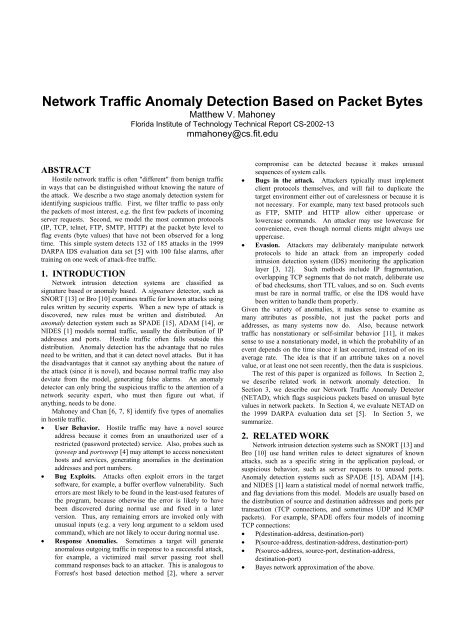
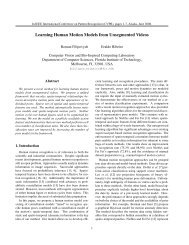
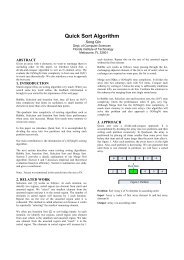
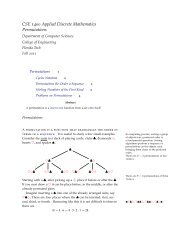
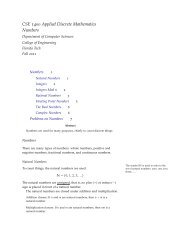
![{ public static void main (String[] args) { System.out.println (](https://img.yumpu.com/49719541/1/190x143/-public-static-void-main-string-args-systemoutprintln-hello-.jpg?quality=85)
